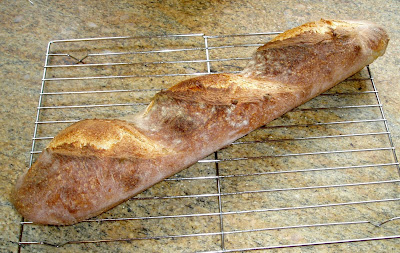When I first saw pictures of this bread in The Bread-Baker's Apprentice, I knew I had to try it. The beautiful S-shape and the deep brown crust sprinkled with sesame seeds just called to me. I'm so glad it did--it's one of the most delicious breads I've ever made. As a testament to the irrestible nature of this bread, I baked three loaves this weekend. On Sunday evening, there is one-half of a piece left. (I did give one loaf away, but still...).
The directions say this is a three-day process. Day 1: Make the pate fermentee. Day 2: Mix, shape, and let rise in the refrigerator. Day 3: Bake.
The pate fermentee was easy--just a mixture of bread flour, durum flour, salt, water, and yeast. (The recipe calls for semolina flour, but Rose likes durum flour better, and I think she's right).
The second day was the fun part. The pate fermentee is mixed with more bread and durum flours, more salt, water, and yeast, plus olive oil and honey. After this rises for a few hours, it's shaped. You cut the dough in thirds, roll and stretch each part into a long, thin 24-inch cylinder. Then you wind each side up toward the center, going in opposite directions. Spray with water, sprinkle withs sesame seeds, then spray with oil, and place on parchment-papered baking sheets. Cover loosely with plastic wrap and refrigerate.

Now, I honestly did not believe that this was going to work. The glossy photos of this bread looked so beautiful, so professional, that I figured mine would be a sad, clumsy approximation. But they were doing so well in their unbaked state that I couldn't resist baking one yesterday, even though Peter Reinhart says they have to stay refrigerated at least overnight to develop their full flavor.

I was so pleased when I saw this that I didn't even care if it was lacking its full flavor potential. We had it for dinner, with spicy grilled shrimp and steamed asparagus. It was such a low-fat dinner that we felt no guilt at all as we ate piece after piece of bread. The crust was perfect, and the bread itself had such depth of flavor that it didn't need butter or olive oil. (Although they didn't hurt it).

Reinhart has a different method for oven-steaming than Rose does. Instead of using ice cubes, he recommends pouring very hot water into a pre-heated pan. That was scary. I had boiled the water about a half-hour before I needed it, so it was quite hot. When I poured it into the pan, which had been pre-heated to 500, it snapped, sizzled, and jumped all over the oven. It did make a lovely crust, but it also scared the bejesus out of me, so I rejected that method.
Today, when I made the second and third loaves, I put room temperature water into the preheated pan. That was much less frightening, although it probably didn't make as much steam. These two loaves also came out looking quite photogenic. I told Jim and Sarah that the second and third loaves, which had been in the refrigerator an extra 24 hours, should have a noticeably more developed flavor, so we were all forced to do taste tests. The verdict: loaves two and three were possibly better--in an extremely subtle way--than loaf one. But loaf one was so good that you should feel free to make this bread if you have only two days to putter around the kitchen.

This Sicilian bread is highly satisfactory to make and beautiful to present. It kept making me wish that I had the tiniest bit of Italian ancestry--I had such an urge to pass this off as a recipe from my great-grandmother. In fact, I was trying to sound like an Italian grandmother in the kitchen in hopes of somehow giving off an aura of authenticity, but I ended up sounding like Carmela Soprano. Fortunately, that didn't hurt the bread.



























